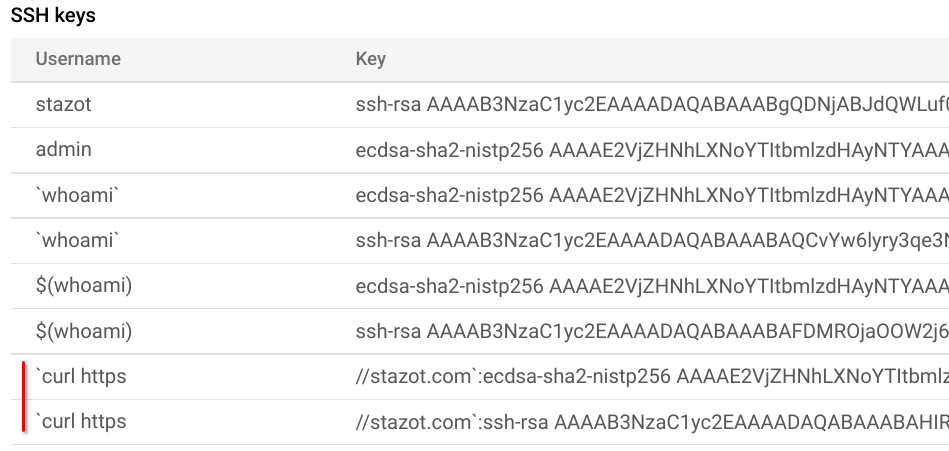
2023-6-25 19:8:20 Author: govuln.com(查看原文) 阅读量:30 收藏
This write-up is the first in a series of write-ups about bugs that I, and Sreeram, found in Google Cloud during 2022.
After hunting for bugs continuously in common Google apps such as Drive, we wanted to venture into Google Cloud. This was the first bug we discovered in the platform, which had the impact of a single-click RCE in a victim user's Compute Engine instance.
Since this was our first step into Google Cloud, we naturally stumbled upon one of the most popular products, Compute Engine. While exploring its features and how it works, I noticed "SSH-in-browser." It is a feature in GCP that lets users access their compute instances, through SSH, via the browser. Visually, this interface looks very similar to Cloud Shell.

I was looking at the different features and options of SSH-in-browser. One feature that caught my eye was "Change Linux Username."

This dialog takes an input username from the user, which is then passed to the server via a GET parameter newLinuxUsername. Even if the given username doesn’t exist, it’ll create a new user with the provided username and log you in as that user.
https://ssh.cloud.google.com/v2/ssh/projects/{PROJECT-NAME}/zones/{INSTANCE-ZONE}/instances/{INSTANCE-NAME}?newLinuxUsername={USERNAME}Since there was no random token or CSRF protection, anyone could craft a link and send it to a Compute Engine user to create a new user in their instance. Not that impactful, but something to note. But the interesting part was that, at least on a surface level, it looked like it was just taking user input and passing it to useradd or adduser commands. So, command injection?
I tried to add payloads such as `whoami`, $(whoami), to see if it gets executed. However, nothing happened. To check for second-order command execution, I tried `curl https://stazot.com` as the payload. Again, nothing happened. I returned to the Compute Engine instance page and started looking for other things.
I noticed that under the "SSH Keys" section, the usernames that I tried as payload were listed. This section contains the list of all users of the instance and their respective added/generated SSH keys. While payloads such as `whoami` were displayed as is, the curl payload was listed in a weird way.

The username field contained `curl http, and the SSH key field contained stazot.com`:ssh-key-value. Instantly, bells started ringing in my head.
The server was using the colon symbol : as a delimiter. Anything before : was considered the username, and everything after : was considered the SSH key for that user. Theoretically, this should allow an attacker to inject a username and their public SSH key. This is possible because, as noted earlier, the server took this input in a GET request and had no CSRF protection.
So, making a victim open a malicious link would add the attacker's username and SSH key into their compute instance. To confirm the bug, I constructed the following URL with attacker:{URL-ENCODED-SSH-PUBLIC-KEY} as the payload:
https://ssh.cloud.google.com/v2/ssh/projects/{PROJECT-NAME}/zones/{INSTANCE-ZONE}/instances/{INSTANCE-NAME}?newLinuxUsername=attacker:{URL-ENCODED-SSH-PUBLIC-KEY}Opened the link as the victim - and I tried to log into the compute instance as the attacker. However, it did not work. The reason was that the SSH key I added was then appended with the SSH key that Google generated in the backend. To fix this, I appended newline return characters to the payload:
https://ssh.cloud.google.com/v2/ssh/projects/{PROJECT-NAME}/zones/{INSTANCE-ZONE}/instances/{INSTANCE-NAME}?newLinuxUsername=attacker:{URL-ENCODED-SSH-PUBLIC-KEY}%0d%0aOnce this victim opened this link, I tried to log into that instance as the attacker - and it worked! I was logged into the target machine with sudo privileges.
🎉
Here is the video demonstrating the attack:
Why did this bug exist?
This behavior existed to facilitate authorization via the SSH-in-browser feature. Since the browser acts like an SSH client, it needs an authorized SSH key to log into the instance.
Compute Engine handles this by creating an SSH key for each user in the instance (that uses SSH-in-browser) and storing it in the instance metadata. When the user logs in using SSH-in-browser, the instance fetches all the authorized SSH keys from the metadata server and logs in the user.
This is a very elaborate process, which is explained here in detail.
Disclosure
We received a $5000 bounty and a $1000 bonus for reporting this bug to Google VRP.
Rationale for this decision:
Bug of the week! Cool bug :D
Timeline
Jul 14, 2022 - Reported
Jul 15, 2022 - Closed as Intended Behavior
Jul 15, 2022 - Further explanation was sent
Jul 16, 2022 - Unable to reproduce
Jul 16, 2022 - PoC video was sent
Jul 23, 2022 - 🎉 Nice catch!
Jul 26, 2022 - Rewarded a $6000 bounty
如有侵权请联系:admin#unsafe.sh